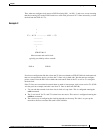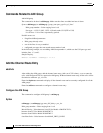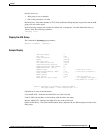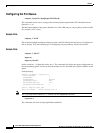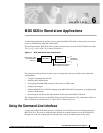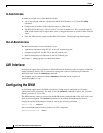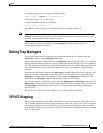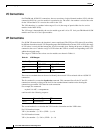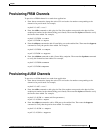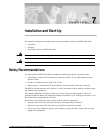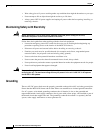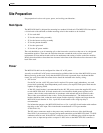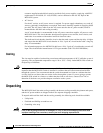
6-3
Cisco MGX 8220 Installation and Configuration
Release 5.0, Part Number 78-6430-03 Rev. D0, November 2003
Chapter
Setting Trap Managers
Use the following syntax to configure the BNM interface:
shelf.1.3.ASC.a > cnfbnmif -if <interfaceFormat>
<interfaceFormat> = 2-3, 2: UNI, 3: NNI
Configure the BNM interface to UNI format,
shelf.1.3.ASC.a > cnfbnmif -if 2
If the BNM-T3 card is being used, the ATM line must be configured with PLCP.
Note The BNM interface cannot be configured while connections exist on the MGX 8220 shelf. The
clrallcnf command can be entered to clear the entire configuration. This command will also reset
the MGX 8220 shelf and terminate all telnet sessions.
The interface format can be confirmed with the dspbnmif command and the response of
“bnmLineInterfaceFormat: bnmUni.”
Setting Trap Managers
In stand-alone applications, trap managers are configured through the CLI entering either the
cnftrapmgr command or the addtrapmgr command.
Trap managers registered (added) entering the cnftrapmgr command will age. That is to say the trap
manager will be disabled automatically after 30 minutes and must be reregistered if it is to continue to
exist. The function of reregistering is normally accomplished by the Cisco WAN Manager (CWM), but
since CWM cannot be used for stand-alone applications, there is no method for reregistering trap
managers.
In stand-alone applications, therefore, the addtrapmgr command should be entered to register a trap
manager. Using this command the trap manager does not age and exists until de registered by the
deltrapmgr command. Once a trap manager is registered by the addtrapmgr command it can be
modified by the cnftrapmgr command and the trap manager will still not age.
Current trap managers can be displayed using either the dsptrapmgrs or dsptrapmgr commands. The
dsptrapmgrs command displays all current trap managers but does not include time-out information.
The dsptrapmgr command displays the status for a single specified trap manager including the
time-out status.
Refer to the Cisco MGX 8220 Command Reference for details of these commands.
VPI/VCI Mapping
When creating connections on the MGX 8220 shelf the user does not explicitly assign VPI and VCI
values. Instead, the MGX 8220 shelf takes user-entered values such as DLCI, LCN, and so forth, and
uses mapping algorithms to calculate VPI/VCI values. In stand-alone applications, the user needs to
know how this mapping works since these VPI and VCI values must be configured into the connected
router or ATM switch.



